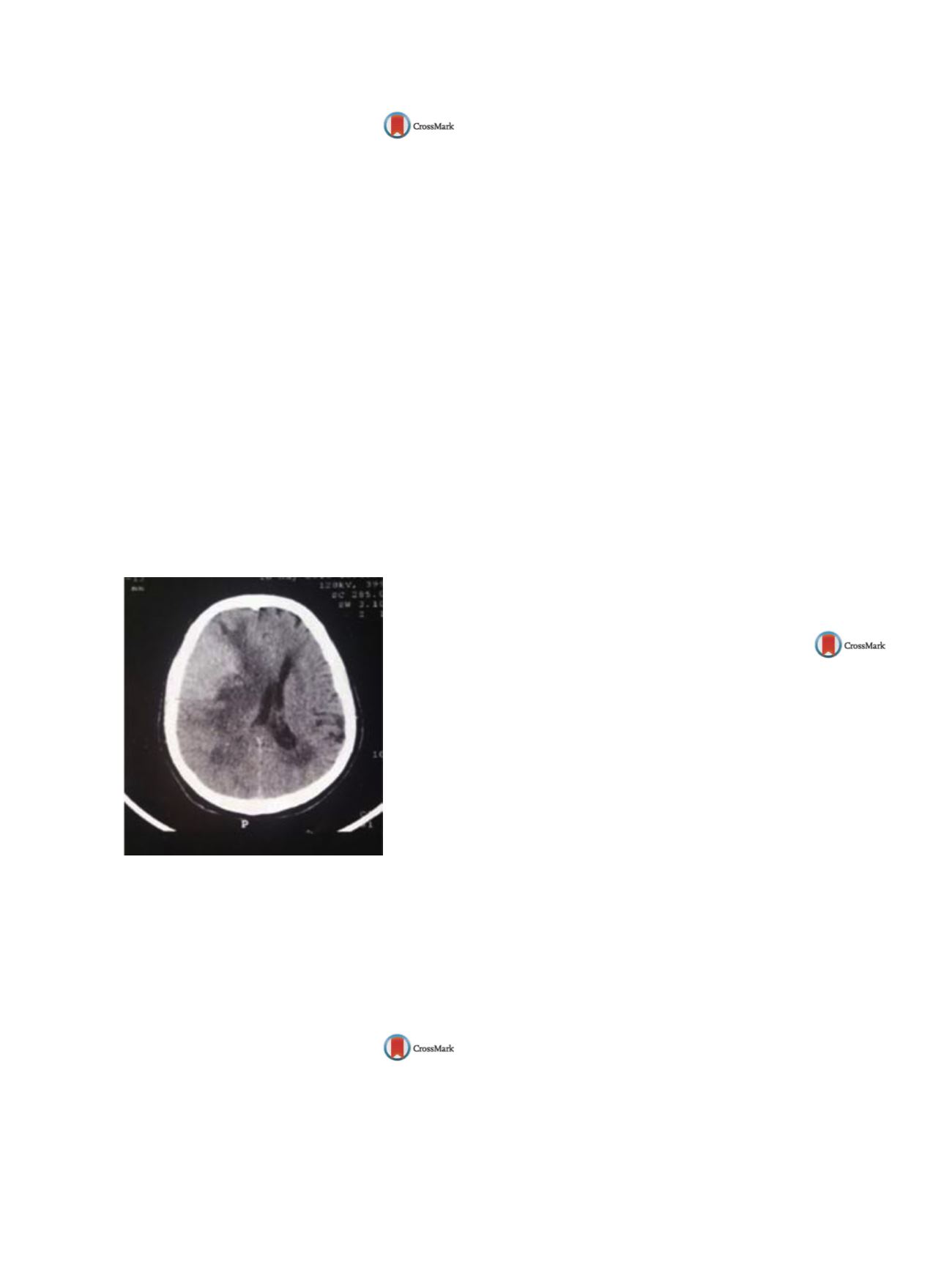

S678
25th European Congress of Psychiatry / European Psychiatry 41S (2017) S645–S709
EV0840
Frontal meningioma and bipolar
disorder: Etiopathogenic link or
co-morbidity? A case report
I. Chaari
∗
, H. Ben Ammar , R. Nefzi , N. Mhedhbi , E. Khelifa ,
A. Aissa , Z. El Hechmi
Razi Hospital, F Psychiatry Department, Mannouba, Tunisia
∗
Corresponding author.
Introduction
Frontal meningiomas are benign brain tumours
known for their late onset. They may be presented by only psychi-
atric symptoms. Thus, the diagnosis at early stages can be missed
or overlooked until the tumour causes neurological deficit.
Case report
We report the case of a 61-year-old man, receiv-
ing a treatment and a follow-up for bipolar disorder for 11 years.
He has history of 3 major depressive episodes, 2 suicide attempts
and a manic episode. The symptoms were initially well con-
trolled by medication. Since 6months, the patient started to
experience atypical symptoms: he had presented disinhibited and
aggressive behaviour, psychomotor instability, pyromania and self-
neglect. The patient did not respond to treatment despite repeated
adjustments. A frontal syndrome was suspected. Cerebral CT scan
revealed an unexpected mass measuring 6.8 cm
×
5.6 cm at the
right frontal area, suggestive of a giant meningioma (Fig 1).
Conclusions
Generally, once diagnosed, psychiatric disorders are
rarely revised. Consequently, “silent” tumours such as frontal
meningiomas can be overlooked. Neuroimaging should be consid-
ered in case of new-onset psychiatric symptoms, atypical or change
in clinical presentation.
Fig. 1
The tumor was totally resected and the frontal syndrome
disappeared. The mood disorder is again controlled by usual treat-
ment
Disclosure of interest
The authors have not supplied their decla-
ration of competing interest.
http://dx.doi.org/10.1016/j.eurpsy.2017.01.1170EV0841
Development of a preliminary tool to
assess care-giving practices by family
members with Schizophrenia:
A report from India
S. Das
Assistant Professor, Department of Psychiatry, Government Medical
College and Hospital, 160030 Chandigarh, India
Introduction
Care-giving practices by family members have
inherent value and importance in the provision of care for patients
with schizophrenia. There is dearth of assessment tools that focus
on practices followed by caregivers’ while dealing with their rela-
tives with schizophrenia, especially from India.
Objective
To develop a tool for the assessment of ‘care-giving
practices’ followed by family members while caring for their
patients with schizophrenia.
Aims
(a) To construct a reliable and valid tool on ‘care-giving
practices’ followed by family members while caring for their
patients with schizophrenia; (b) To determine the various ‘good’
and ‘bad’ practices within this tool.
Methods
Initial detailed literature (Pubmed, Goggle search with
input by the caregivers generated a list of 24 commonly used prac-
tices; which was shortened to 17 statements whose face validity
was tested by 14 mental health professionals. Hindi translation
with ‘test-retest’ reliability was conducted. Finally, ‘Consensus
based approach’ was adopted by the mental health professionals
to arrive at objective (b) i.e. statements reflecting ‘good’ or ‘bad’
practice.
Results
Final questionnaire comprised 15 statements with ade-
quate face and content validity and high test-retest reliability
(Cronbach’s alpha = 0.747). 6 items reflected ‘good’ and 9 reflected
‘poor’ practice respectively with maximum score of 15; and cate-
gorization from ‘very poor’ to ‘very good’ practices.
Conclusion
This preliminary yet simple and easy to use tool will
give better understanding about how family members provide
‘care-giving’ practices for patients with schizophrenia. However,
this needs further validation, replicability, and possible modifica-
tions in a multi-cultural, multi-linguistic country like India.
Disclosure of interest
The authors have not supplied their decla-
ration of competing interest.
http://dx.doi.org/10.1016/j.eurpsy.2017.01.1171EV0842
The effectiveness of emotion
regulation and distress tolerance skills
on improving coping strategies and
reduce perceived stress in prisoners
R. Davooodi
1 ,∗
, S . Ghahari
21
Psychology, Clinical, shaft, Iran
2
Psychology, Clinical, Tehran, Iran
∗
Corresponding author.
Objective
The aim of this study was the effectiveness of emo-
tion regulation and distress tolerance skills on improving coping
strategies and reduce perceived stress in prisoners in Foman city in
Iran.
Method
The study population was consisted of 200 prisoners
of Foman Penitentiary in 2016. Then, 30 prisoners were selected
randomly in two groups (15 persons each group) were replaced.
Emotion regulation and distress tolerance training was given to the
experimental group for 12 sessions and the control group were in
waiting list. Both groups at baseline and end of intervention phase
filled coping responses inventory Bellinger and mouse and Cohen
perceived stress questionnaire – version 14 questions (PSS-14).
Data were analysed by using the software spss22.
Findings
Emotion regulation and distress tolerance skills have
been effective on Improving problem-focused coping strategies and
reduce perceived stress in prisoners (
P <
0/001).
Discussion and conclusion
emotion regulation and distress tol-
erance skills can improve problem-focused coping strategies and
reduce the use of emotion-focused coping strategies and perceived
stress in prisoners.
Keywords
Coping strategies; Distress tolerance; Emotion
regulation; Perceived stress; Prisoners
Disclosure of interest
The authors have not supplied their decla-
ration of competing interest.
http://dx.doi.org/10.1016/j.eurpsy.2017.01.1172

















